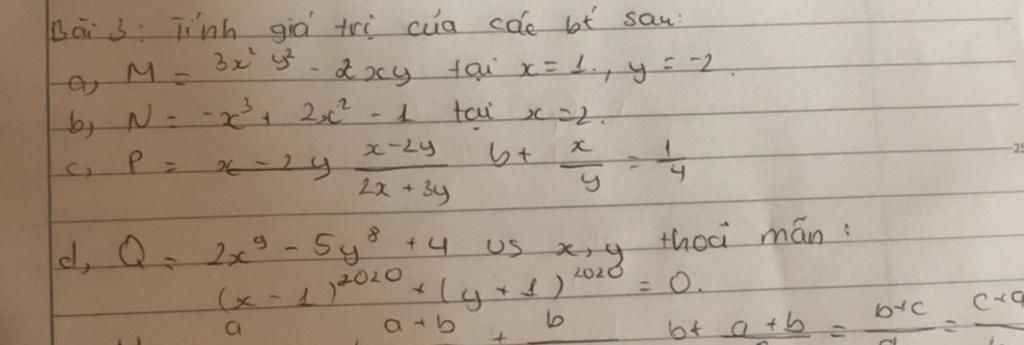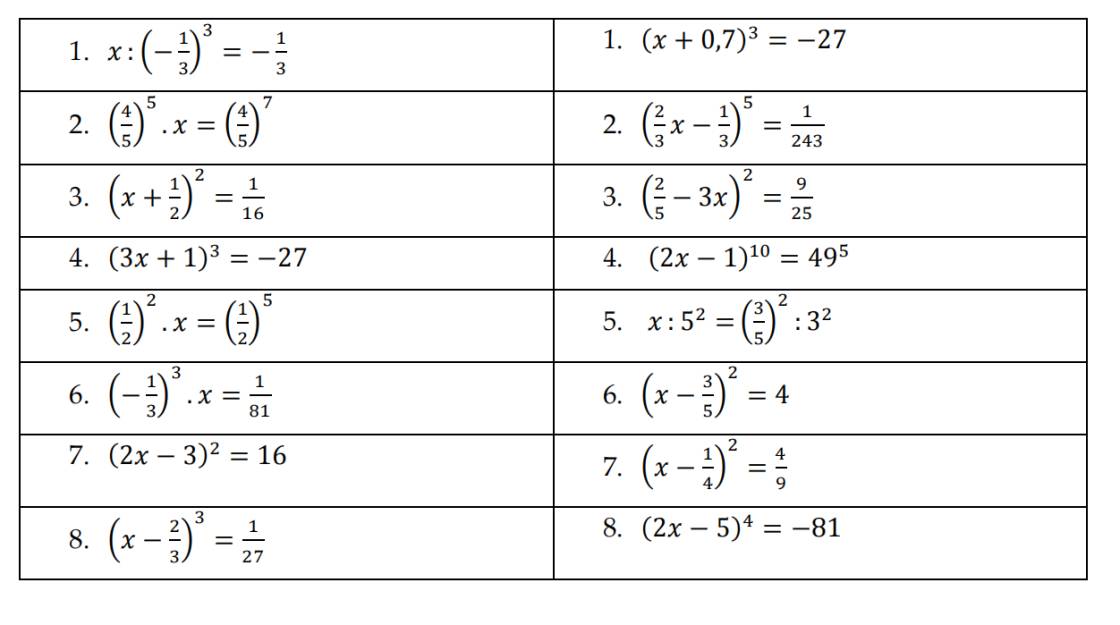
Hãy nhập câu hỏi của bạn vào đây, nếu là tài khoản VIP, bạn sẽ được ưu tiên trả lời.


Với x ≥ 0 thì \(\sqrt{x}\ge0\) nên \(\sqrt{x}+1\ge1\)
Khi đó \(B=\left(\sqrt{x}+1\right)^{99}+2022\ge1^{99}+2022\)
Hay \(B=\left(\sqrt{x}+1\right)^{99}+2022\ge2023\)
Dấu "=" xảy ra khi \(\sqrt{x}=0\) hay x = 0
Vậy GTNN của \(B=\left(\sqrt{x}+1\right)^{99}+2022\) là 2023 khi x = 0
\(B=\left(\sqrt{x}+1\right)^{99}+2022\left(x\ge0\right)\)
Vì: \(x\ge0\)
Nên => \(\left(\sqrt{x}+1\right)^{99}\ge0\)
=> \(\left(\sqrt{x}+1\right)^{99}+2022\ge2022\)
=> \(B\ge2022\)
Dấu " = " xảy ra khi: \(\Leftrightarrow\sqrt{x}+1=0\Leftrightarrow\sqrt{x}=-1\left(voli\right)\)
Vậy: B không có giá trị nhỏ nhất

Lời giải:
$27\equiv 1\pmod {13}$
$\Rightarrow 27^{12}\equiv 1^{12}\equiv 1\pmod {13}(1)$
$43\equiv 4\pmod {13}\Rightarrow 43^7\equiv 4^7\pmod {13}(2)$
$9\equiv -4\pmod {13}\Rightarrow 9^{17}\equiv (-4)^{17}\pmod {13}(3)$
Từ $(1); (2); (3)\Rightarrow 27^{12}+43^7+9^{17}\equiv 1+4^7+(-4)^{17}$
$\equiv 1+4^7(1-4^{10})\pmod {13}$
Mà:
$4^3\equiv -1\pmod {13}$
$\Rightarrow 4^7=(4^3)^2.4\equiv (-1)^2.4\equiv 4\pmod {13}$
$4^{10}=(4^3)^3.4\equiv (-1)^3.4\equiv -4\pmod {13}$
$\Rightarrow 27^{12}+43^7+9^{17}\equiv 1+4^7(1-4^{10})\equiv 1+4(1--4)\equiv 21\equiv 8\pmod {13}$
Tức là tổng trên không chia hết cho 13 bạn nhé.

Lời giải:
Gọi mẫu của ps đó là $x$ với $x$ là số nguyên. Theo bài ra ta có:
$\frac{-11}{3}< \frac{-9}{x}< \frac{-11}{5}$
$\Rightarrow \frac{11}{3}> \frac{9}{x}> \frac{11}{5}$
$\Rightarrow \frac{99}{27}> \frac{99}{11x}> \frac{99}{45}$
$\Rightarrow 27< 11x< 45$
$\Rightarrow 2< x< 5$
$\Rightarrow $x=3$ hoặc $x=4$. Vậy hai phân số cần tìm là $\frac{-9}{3}$ và $\frac{-9}{4}$

\(\left|x\right|+x=\dfrac{1}{3}\)
\(\Rightarrow\left|x\right|=\dfrac{1}{3}-x\)
\(\left|x\right|=\left\{{}\begin{matrix}xkhix\ge0\\-xkhix< 0\end{matrix}\right.\)
Với \(x\ge0\Rightarrow x=\dfrac{1}{3}-x\Rightarrow2x=\dfrac{1}{3}\Rightarrow x=\dfrac{1}{6}\left(tm\right)\)
Với \(x< 0\Rightarrow-x=\dfrac{1}{3}-x\Rightarrow-x+x=\dfrac{1}{3}\Rightarrow0=\dfrac{1}{3}\left(VL\right)\)
Vậy \(x=\dfrac{1}{6}\)
\(\left|x\right|+x=\dfrac{1}{3}\left(1\right)\)
TH1 : \(x\ge0\)
\(\left(1\right)=>x+x=\dfrac{1}{3}\\ =>2x=\dfrac{1}{3}\\ =>x=\dfrac{1}{3}:2=\dfrac{1}{6}\left(TMDK\right)\)
\(TH2:x< 0\)
\(\left(1\right)=>-x+x=\dfrac{1}{3}\\ =>0=\dfrac{1}{3}\)( Vô lí )
Vậy `x=1/6`

\(2.16\ge2^n>4\)
\(2.2^4\ge2^n>2^2\)
\(2^5\ge2^n>2^2\)
=> \(n\in\left\{3,4,5\right\}\)
Vậy: \(n\in\left\{3,4,5\right\}\)

a) Để A là phân số thì : \(n-2\ne0=>n\ne2\)
b) Để A nhận giá trị nguyên âm lớn nhất
\(=>A=-1\\ =>\dfrac{n-6}{n-2}=-1\\ =>n-6=-\left(n-2\right)\\ =>n-6=-n+2\\ =>n+n=6+2\\ =>2n=8\\ =>n=4\left(TMDK\right)\)
c) \(A=\dfrac{n-6}{n-2}=\dfrac{n-2-4}{n-2}=1-\dfrac{4}{n-2}\)
Để A nhận gt số nguyên thì : \(\dfrac{4}{n-2}\in Z=>4⋮\left(n-2\right)\\ =>n-2\inƯ\left(4\right)=\left\{\pm1;\pm2;\pm4\right\}\\ =>n\in\left\{3;1;4;0;6;-2\right\}\)
Đến đây bạn lập bảng giá trị rồi thay từng gt n vào bt A, giá trị nào cho A là STN thì bạn nhận gt đó ạ.
d) Mình nghĩ bạn thiếu đề ạ

\(1,x:\left(-\dfrac{1}{3}\right)^3=\left(-\dfrac{1}{3}\right)\\ \Leftrightarrow x=\left(-\dfrac{1}{3}\right)\times\left(-\dfrac{1}{3}\right)^3\\ \Leftrightarrow x=\left(-\dfrac{1}{3}\right)^4=\dfrac{1}{81}\\ 2,\left(\dfrac{4}{5}\right)^5.x=\left(\dfrac{4}{5}\right)^7\\ \Leftrightarrow x=\left(\dfrac{4}{5}\right)^7:\left(\dfrac{4}{5}\right)^5=\left(\dfrac{4}{5}\right)^{7-5}=\left(\dfrac{4}{5}\right)^2=\dfrac{16}{25}\)
\(3,\left(x+\dfrac{1}{2}\right)^2=\dfrac{1}{16}\\ \Leftrightarrow\left[{}\begin{matrix}x+\dfrac{1}{2}=\dfrac{1}{4}\\x+\dfrac{1}{2}=-\dfrac{1}{4}\end{matrix}\right.\\ \Leftrightarrow\left[{}\begin{matrix}x=-\dfrac{1}{4}\\x=-\dfrac{3}{4}\end{matrix}\right.\)
\(4,\left(3x+1\right)^3=-27\\ \Leftrightarrow\left(3x+1\right)^3=\left(-3\right)^3\\ \Leftrightarrow3x+1=-3\\ \Leftrightarrow3x=-4\\ \Leftrightarrow x=-\dfrac{4}{3}\)
\(5,\left(\dfrac{1}{2}\right)^2.x=\left(\dfrac{1}{2}\right)^5\\ \Leftrightarrow x=\left(\dfrac{1}{2}\right)^5:\left(\dfrac{1}{2}\right)^2\\ \Leftrightarrow x=\left(\dfrac{1}{2}\right)^{5-2}=\left(\dfrac{1}{2}\right)^3=\dfrac{1}{8}\)
\(6,\left(-\dfrac{1}{3}\right)^3.x=\dfrac{1}{81}\\ \Leftrightarrow\left(-\dfrac{1}{3}\right)^3.x=\left(-\dfrac{1}{3}\right)^4\\ \Leftrightarrow x=\left(-\dfrac{1}{3}\right)^4:\left(-\dfrac{1}{3}\right)^3=-\dfrac{1}{3}\)
\(7,\left(2x-3\right)^2=16\\ \Leftrightarrow\left[{}\begin{matrix}2x-3=4\\2x-3=-4\end{matrix}\right.\\ \Leftrightarrow\left[{}\begin{matrix}x=\dfrac{7}{2}\\x=-\dfrac{1}{2}\end{matrix}\right.\)
\(8,\left(x-\dfrac{2}{3}\right)^3=\dfrac{1}{27}\\ \Leftrightarrow\left(x-\dfrac{2}{3}\right)^3=\left(\dfrac{1}{3}\right)^3\\ \Leftrightarrow x-\dfrac{2}{3}=\dfrac{1}{3}\\ \Leftrightarrow x=\dfrac{1}{3}+\dfrac{2}{3}=\dfrac{3}{3}=1\)
`@` `\text {Ans}`
`\downarrow`
(Vế 1)
`1.`
`x \div(-1/3)^3 =-1/3`
`=> x= (-1/3) \times (-1/3)^3`
`=> x= (-1/3)^4`
`2.`
`(4/5)^5 *x = (4/5)^7`
`=> x = (4/5)^7 \div (4/5)^5`
`=> x=(4/5)^2`
`3.`
`(x+1/2)^2 =1/16`
`=> (x+1/2)^2 = (+-1/4)^2`
`=>`\(\left[{}\begin{matrix}x+\dfrac{1}{2}=\dfrac{1}{4}\\x+\dfrac{1}{2}=-\dfrac{1}{4}\end{matrix}\right.\)
`=>`\(\left[{}\begin{matrix}x=\dfrac{1}{4}-\dfrac{1}{2}\\x=-\dfrac{1}{4}-\dfrac{1}{2}\end{matrix}\right.\)
`=>`\(\left[{}\begin{matrix}x=-\dfrac{1}{4}\\x=-\dfrac{3}{4}\end{matrix}\right.\)
`4.`
`(3x+1)^3 = -27`
`=> (3x+1)^3 = (-3)^3`
`=> 3x+1=-3`
`=> 3x=-3-1`
`=> 3x =-4`
`=> x=-4/3`
`5.`
`(1/2)^2*x=(1/2)^5`
`=> x=(1/2)^5 \div (1/2)^2`
`=> x=(1/2)^3`
`6.`
`(-1/3)^3*x=1/81`
`=> (-1/3)^3*x = (1/3)^4`
`=> x= (1/3)^4 \div (-1/3)^3`
`=> x=(-1/3)`
`7.`
`(2x-3)^2 = 16`
`=> (2x-3)^2 = (+-4)^2`
`=>`\(\left[{}\begin{matrix}2x-3=4\\2x-3=-4\end{matrix}\right.\)
`=>`\(\left[{}\begin{matrix}2x=7\\2x=-1\end{matrix}\right.\)
`=>`\(\left[{}\begin{matrix}x=\dfrac{7}{2}\\x=-\dfrac{1}{2}\end{matrix}\right.\)
`8.`
`(x-2/3)^3 = 1/27`
`=> (x-2/3)^3 = (1/3)^3`
`=> x-2/3=1/3`
`=> x=1/3 + 2/3`
`=> x=1`

\(9.27\le3n\le243\\ =>9.27:3\le3n:3\le243:3\\=>81\le n\le81\\ =>n=81\)
\(9.27\le3^n\le243\)
\(3.3^3\le3^n\le3^5\)
\(3^4\le3^n\le3^5\)
\(n\in\left\{4,5\right\}\)
Vậy: \(n\in\left\{4,5\right\}\)

Bài 3: Tính giá trị của
a, M = 3\(x^2\)y2 - 2\(xy\) - 1 tại \(x\) = 1; \(y\) = -2
Thay \(x\) = 1; \(y\) = -2 vào biểu thức M = 3\(x^2\)y2 - 2\(xy\) - 1 ta có:
M = 3.(1)2.(-2)2 - 2.(1)2.(-2) = 12 + 4 = 16
b, N = -\(x\)3 + 2\(x\)2 - 1 tại \(x\) = 2
Thay \(x\) = 2 vào biểu thức N = - \(x^3\) + 2\(x^2\) - 1 ta có:
N = -(2)3 +2.(2)2 - 1 = -1
c, Không rõ tại \(x\) = ?; \(y\) = ?
d, Q = 2\(x^9\) - 5\(y\)8 + 4 và \(x;y\) thỏa mãn (\(x-1\))2020 +(\(y\) +1)2020
Ta có: \(\left\{{}\begin{matrix}\left(x-1\right)^{2020}\ge0\forall x\\\left(y+1\right)^{2020}\ge0\forall x\end{matrix}\right.\)
⇒ (\(x-1\))2020+(y+1)2020 = 0
⇔ \(\left\{{}\begin{matrix}x-1=0\\y+1=0\end{matrix}\right.\) ⇔ \(\left\{{}\begin{matrix}x=1\\y=-1\end{matrix}\right.\)
Thay \(\left\{{}\begin{matrix}x=1\\y=-1\end{matrix}\right.\) vào biểu thức:
Q = 2\(x^9\) - 5\(y^8\) + 4 ta có:
Q = 2.(1)9 - 5.(-1)8 + 4 = 2 - 5 + 4 = 1
giúp mình với ạ